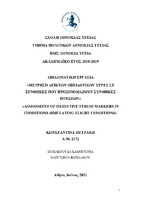| dc.contributor.advisor | Vassilakou, Tonia | |
| dc.contributor.author | Πετράκη, Κωνσταντίνα | |
| dc.date.accessioned | 2021-06-24T13:09:57Z | |
| dc.date.issued | 2021-06-10 | |
| dc.identifier.uri | https://polynoe.lib.uniwa.gr/xmlui/handle/11400/712 | |
| dc.identifier.uri | http://dx.doi.org/10.26265/polynoe-563 | |
| dc.description.abstract | Η υποξία αποτελεί μια κατάσταση, κατά την οποία ο οργανισμός βρίσκεται σε έλλειψη οξυγόνου για ένα διάστημα. Η υποξία έχει συσχετιστεί με την παραγωγή ελεύθερων ριζών (ROS). Οι ROS, όταν παράγονται στο κύτταρο σε μεγάλες ποσότητες, μπορεί να οδηγήσουν σε εμφάνιση οξειδωτικού στρες.
Σκοπός:
Σκοπός της παρούσας εργασίας ήταν η διερεύνηση της εμφάνισης οξειδωτικού στρες σε εθελοντές που εκτέθηκαν σε συνθήκες υποξίας.
Υλικό και Μέθοδος:
Στην έρευνα συμμετείχαν εθελοντές πιλότοι και μαθητευόμενοι πιλότοι που χωρίστηκαν σε δυο ομάδες. Η πρόκληση των συνθηκών υποξίας πραγματοποιήθηκε στο θάλαμο χαμηλής πίεσης του Κέντρου Αεροπορικής Ιατρικής της Πολεμικής Αεροπορίας. Πριν και μετά την δοκιμασία αναλύθηκαν φασματοφωτομετρικά 5 δείκτες οξειδοαναγωγικής κατάστασης, η ανηγμένη γλουταθειόνη (GSH), η ολική αντιοξειδωτική ικανότητα (TAC), η λιπιδική υπεροξείδωση (TBARS), τα πρωτεινικά καρβονύλια (CARB), και η δραστικότητα καταλάσης (CAT) σε δείγμα αίματος των εθελοντών.
Αποτελέσματα:
Οι δείκτες CARB, TBARS, TAC και GSH δεν μεταβλήθηκαν σε καμιά ομάδα λόγω της παρέμβασης. Μόνο η δραστικότητα καταλάσης αυξήθηκε στην ομάδα των μαθητευόμενων πιλότων μετά την παρέμβαση, καθώς η συγκεκριμένη ομάδα εκτέθηκε για πρώτη φορά σε συνθήκες υποξίας. Επιπρόσθετες διαφορές υπήρχαν μεταξύ των ομάδων στα CARB και στην TAC, οι οποίες δεν σχετίζονται με την παρέμβαση. Οι έμπειροι πιλότοι παρουσίασαν αυξημένα επίπεδα TAC και CARB πριν την παρέμβαση γεγονός που υποδηλώνει κάποιες προσαρμογές που οφείλονται πιθανώς στην ηλικία, αλλά και στην συνεχή έκθεση σε συνθήκες υποξίας.
Συμπεράσματα:
Το πρωτόκολλο υποξίας επηρέασε διαφορετικά τα επίπεδα δεικτών οξειδοαναγωγικής κατάστασης στους έμπειρους πιλότους και στους μαθητευόμενους, υποδεικνύοντας πιθανές προσαρμογές στην ομάδα των πιλότων. | el |
| dc.format.extent | 115 | el |
| dc.language.iso | el | el |
| dc.publisher | Πανεπιστήμιο Δυτικής Αττικής | el |
| dc.rights | Αναφορά Δημιουργού - Μη Εμπορική Χρήση - Παρόμοια Διανομή 4.0 Διεθνές | * |
| dc.rights.uri | https://creativecommons.org/licenses/by-nc-sa/4.0/deed.el | * |
| dc.subject | Αντιοξειδωτικά | el |
| dc.subject | Οξειδωτικό στρες | el |
| dc.subject | Ελεύθερες ρίζες | el |
| dc.subject | Υποξία | el |
| dc.subject | Πιλότοι | el |
| dc.subject | Antioxidants | el |
| dc.subject | Oxidative stress | el |
| dc.subject | Free radicals | el |
| dc.subject | Hypoxia | el |
| dc.subject | Pilots | el |
| dc.title | Μέτρηση δεικτών οξειδωτικού στρες σε συνθήκες που προσομοιάζουν συνθήκες πτήσεων. | el |
| dc.title.alternative | Assessment of oxidative stress markers in conditions simulating flight conditions | el |
| dc.type | Μεταπτυχιακή διπλωματική εργασία | el |
| dc.contributor.committee | Κουρέτας, Δημήτριος | |
| dc.contributor.committee | Κοτροκόης, Κωνσταντίνος | |
| dc.contributor.faculty | Σχολή Δημόσιας Υγείας | el |
| dc.contributor.department | Τμήμα Πολιτικών Δημόσιας Υγείας | el |
| dc.contributor.master | Δημόσιας Υγείας | el |
| dc.description.abstracttranslated | Hypoxia is a condition, in which the body is deficient in oxygen for a period of time. Hypoxia has been linked to the production of free radicals (ROS). When ROS are produced in large amounts within the cells, it could lead to oxidative stress.
Aim:
The aim of the present study was to examine the occurrence of oxidative stress in volunteers exposed to hypoxia.
Methods:
Volunteer pilots and trainee pilots participated in the research divided into two groups. The hypoxia was induced in the low-pressure chamber of the Aviation Medicine Center. Before and after the test, 5 biomarkers of redox status were analyzed spectrophotometrically in blood samples of the volunteers. The biomarkers analyzed were: reduced glutathione (GSH), total antioxidant capacity (TAC), lipid peroxidation (TBARS), protein carbonyls (CARB) and Catalase activity (CAT).
Results:
The CARB, TBARS, TAC and GSH indices did not change in any group due to the intervention. Only catalase activity increased in the trainee pilot group after the intervention as this group was exposed to hypoxia for the first time in their life. There were additional differences between the groups in CARB and TAC, which are not related to the intervention. Experienced pilots showed increased levels of TAC and CARB before the intervention in relation to the trainees, which suggests some adjustments due to different age, but also to regular exposure to hypoxia.
Conclusions:
Hypoxia intervention affected differentially the oxidative stress biomarkers among the experienced pilots and the trainees, indicating possible adjustments in the group of the experienced pilots. | el |
| dcterms.embargoTerms | 12 months | el |
| dcterms.embargoLiftDate | 2022-06-24T13:09:57Z | |


